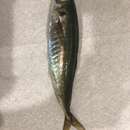Diagnostic Description
provided by Fishbase
Small specimens may have an additional forward-directed spine at first dorsal origin (embedded in larger specimens).
- Recorder
- Cristina V. Garilao
Migration
provided by Fishbase
Oceanodromous. Migrating within oceans typically between spawning and different feeding areas, as tunas do. Migrations should be cyclical and predictable and cover more than 100 km.
Morphology
provided by Fishbase
Dorsal spines (total): 8 - 9; Dorsal soft rays (total): 28 - 38; Anal spines: 1 - 2; Analsoft rays: 22 - 33; Vertebrae: 23 - 25
- Recorder
- Cristina V. Garilao
Trophic Strategy
provided by Fishbase
Often found offshore, up to 500 miles from the coast (Ref. 9283). Forms large schools (Ref. 2850). Young frequently occur in school near kelp and under piers (Ref. 2850). Feeds mainly on small crustaceans and fish larvae (Ref. 9283). Large individuals often move inshore and north in the summer (Ref. 2850).
Biology
provided by Fishbase
Adults are often found offshore, up to 500 miles from the coast (Ref. 9283). They form large schools (Ref. 2850). Young frequently occur in school near kelp and under piers (Ref. 2850). They feed mainly on small crustaceans and fish larvae (Ref. 9283). Large individuals often move inshore and north in the summer (Ref. 2850). Marketed fresh, smoked, canned and frozen; eaten fried, broiled and baked (Ref. 9988).
Importance
provided by Fishbase
fisheries: commercial; gamefish: yes

